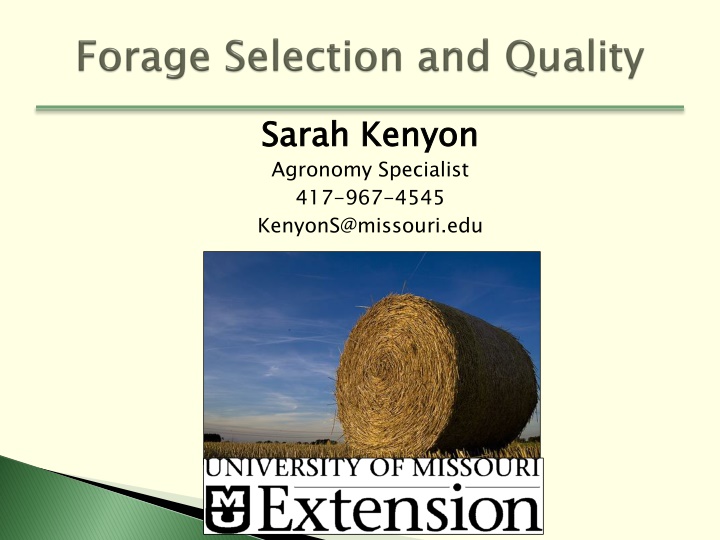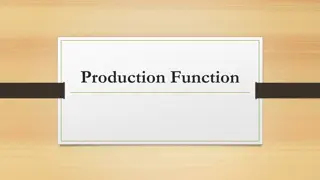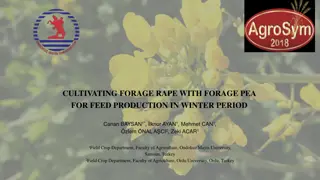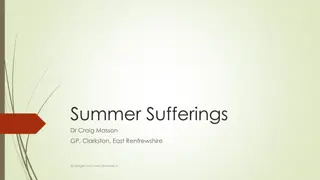Guide to Forage Selection and High-Quality Hay Production
Discover what you can grow for forage selection and learn about the key factors that make high-quality hay, including perennial ryegrass, smooth bromegrass, tall fescue, and orchardgrass. Find insights on forage growth rates throughout the year to optimize your hay production.
Download Presentation

Please find below an Image/Link to download the presentation.
The content on the website is provided AS IS for your information and personal use only. It may not be sold, licensed, or shared on other websites without obtaining consent from the author.If you encounter any issues during the download, it is possible that the publisher has removed the file from their server.
You are allowed to download the files provided on this website for personal or commercial use, subject to the condition that they are used lawfully. All files are the property of their respective owners.
The content on the website is provided AS IS for your information and personal use only. It may not be sold, licensed, or shared on other websites without obtaining consent from the author.
E N D
Presentation Transcript
Sarah Kenyon Agronomy Specialist 417-967-4545 KenyonS@missouri.edu Sarah Kenyon
1. What can I grow? Forage selection 2. What makes a high quality hay? Forage quality
Perennial Ryegrass Forage Growth Rate Smooth Bromegrass Tall Fescue Orchardgrass Feb Apr Jun Aug Oct Dec
Fungus found in stem, leaf sheaths & seed Produces alkaloids toxic to livestock Increases progressively season long Minimized in young growth Roberts and Andrae, 2004
Fescue and the Endophyte Toxicity from Ergovaline and Total Ergot Alkaloids Other alkaloids help with disease, insect, and drought tolerance Found in seedheads and stems
2004 (Roberts et al., in prep)
2005 (Roberts et al., in prep)
Fescue and the Endophyte Hay 1/3 disappears in the first 2 weeks; disappears after 6 months of storage Silage Variable results Moisture levels can alter the results High Moisture (60%) ergovaline disappears; total ergot alkaloids increases Low Moisture (43%) Less abrupt changes Conclusions from MU Studies Conclusions from MU Studies
AR4 Average Daily Gain (lb) 1.43 1.55 1.21 1.21 West et al., 1998 E- E+ Location Fayetteville, AR Mt. Vernon, MO 0.93 0.55
Non-toxic endophytes (Novel or Friendly) Retain persistent qualities Animal performance similar to E- Available Varieties: Jesup Tall Fescue with MaxQ Advance with AR37 Bar-Optima with E34 Texoma with MaxQII Estancia with ArkShield Duramax with Armor Others
Cool season grass Red Clover White Clover Alfalfa Forage Yield Annual Lespedeza Feb Apr Jun Aug Oct Dec
Improved forage quality Fewer problems with fescue toxicosis Improves animal gain Minimizes the need for Nitrogen fertilizer Longer grazing season
2 1.8 1.6 1.4 1.2 1 0.8 0.6 0.4 0.2 0 High Endophyte Low Endophyte Without Clover With Clover Multi-Year Tests on Four Research Farms in TN and GA
Conduct soil samples Legumes require higher fertility Use inoculants February seeding dates have a 50% better chance than April seeding dates
Caucasian bluestem Bermudagrass Cool season grass Forage Yield Feb Apr Jun Aug Oct Dec
Sudangrass Sudangrass Cool Season Grass Cool Season Grass Pearl Millet Pearl Millet Forage Yield Teff Teff Crabgrass Crabgrass Feb Apr Jun Aug Oct Dec
Indiangrass Indiangrass Switchgrass Switchgrass Cool Season Grass Cool Season Grass Big Bluestem Big Bluestem Forage Yield Eastern Gamagrass Eastern Gamagrass Feb Apr Jun Aug Oct Dec
Forage Type Bermudagrass Milk Yield (lb/d) 47.0 CSG Mix 41.3
Forage Species Curing and Handling Conditions Stage of Maturity
Yield, crude protein (CP), and total digestible nutrients (TDN) contents of various hay crops. Yield (ton/Acre) Alfalfa 3-6 Orchardgrass 2-5 Tall Fescue 2-4 Rye 1-4 Ryegrass 1-4 Bermudagrass 5-8 Johnsongrass 2-5 Pearl Millet 2-6 Forage Species CP (%) 17-22 12-15 10-15 8-10 10-16 10-14 10-14 8-12 TDN (%) 57-62 55-60 55-60 50-55 56-62 52-58 50-60 50-58 Values are expressed on a dry matter basis. Adapted from: D.M. Ball et. al. 2008. Southern Forages
Poor weather and handling conditions can lower hay quality Rain can cause leaf loss and nutrient leaching from plants Sunlight can reduce Vitamin A by bleaching Raking dry, brittle hay can cause excessive leaf loss
Apr Apr May May Jun Jun Jul Jul Aug Aug Sept Sept Oct Oct 2007 4.04 4.07 8.11 2.80 4.34 4.93 1.88 2008 4.74 5.20 13.41 2.66 0.60 8.15 2.38 2009 8.26 5.52 4.61 3.70 4.51 5.63 9.97 2010 3.99 7.14 2.33 6.37 1.53 11.65 1.01 2011 7.89 5.92 0.82 1.71 2.88 4.05 1.28 Average 5.78 5.57 5.86 3.45 2.77 6.88 3.39
% CP % CP %ADF %ADF %NDF %NDF %TDN %TDN Rain-Free Hay 16.7 42.2 52.4 54.4 Rained On Hay 13.7 46.2 62.0 49.8 Source: Ann Cowen, Iowa State Univ.
The timing of when rainfall occurs after cutting will influence quality 1. Immediately after cutting Plant cells are still turgid so little moisture enters the cells and leaches the water-soluble cell contents some loss does occur, but is minimal 2. After the hay has dried a while plant cells will re-absorb moisture and greater leaching of cell contents will occur drying will make plants somewhat brittle -- if hard pounding rains occur, leaves can be broken off, which will also lead to dry matter losses and lower quality
Keep doing what weve always done Baleage Baleage
Keep doing what weve always done Baleage April Harvest April Harvest
Lower yield Higher quality 1st and 2nd cutting If too early, seedheads may still emerge
Keep doing what weve always done Baleage April Harvest Late Grazing Late Grazing
March-Early April Late Cutting (June/July) Keeps in vegetative state into a drier season
Keep doing what weve always done Baleage April Harvest Late Grazing Warm Season Forages Warm Season Forages
Native Warm Season Grasses Switchgrass Big Bluestem Introduced Species Bermudagrass Crabgrass Caucasian Bluestem Native Warm Season Grass
TNC = Total Nonstructural CarbohydratesBurns, et al. 2007 Crop Science, 47:2190-2197
TNC = Total Nonstructural CarbohydratesFisher, et al. 2002 Crop Science, 42:231-237
Within each forage species, the most important factor affecting hay quality is stage of maturity.
Clover/Alfalfa 1/3 Bloom Grasses Boot Stage
What is the boot stage? This is the stage just prior to heading out. The flag leaf is fully expanded, but the seed head is not visible. The seed head can be felt in the flag leaf sheath. Each plants ultimate goal is survival, which is dependent on seed production Fall production does not contain reproductive structures
The effect of stage of maturity at harvest on alfalfa hay quality. Acid Stage at Harvest Pre-bloom Early bloom Mid-bloom Full bloom Values are expressed on a dry matter basis. From: Kawas et. al. 1990. Journal of Animal Science. 68:4376. CP (%) 21.1 18.9 14.7 16.3 Detergent Fiber (%) 30.2 33.0 38.0 45.9 Digestibility (%) 63.3 62.4 55.4 53.2
The effect of age on Tifton-44 bermudagrass hay on yield and quality. Yield (lb DM/Acre) (%) 1 Week 8539 19.8 2 Weeks 8603 17.0 4 Weeks 8197 14.1 8 Weeks 13329 9.7 Cutting Interval CP Digestibility (%) 61.8 62.2 61.3 54.3 Values are expressed on a dry matter basis. From: Mason and Burton. 1982. Agronomy Journal. 74.371























